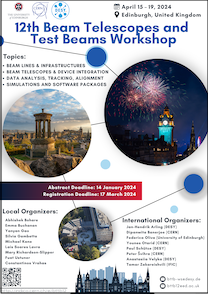Speaker
Description
The Water Cherenkov Test Experiment (WCTE) will be installed in CERN's recently upgraded T9 “Test Beam” Area in Summer 2024. The upgrade to the East Area, completed in 2022, allows the T9 beamline to reach lower beam momenta than previously possible, now down to ~100MeV/c. The WCTE has three goals: to prototype photosensor and calibration systems for Hyper-Kamiokande, to develop new calibration and reconstruction methods for water Cherenkov detectors and to measure lepton and hadron scattering on Oxygen.
The WCTE collaboration performed a 3-week-long beam test in July 2023 to test WCTE's beam telescope in the momentum range of 200-1000MeV/c. The collaboration uses newly developed aerogel Cherenkov counters with an index of refraction between 1.006 and 1.15 to perform an efficient separation of pions from muons in the sub-GeV range, which had not been done before. This makes a test beam where pions and muons are tagged with good efficiency without having to rely on a tertiary beam.
Additionally, the collaboration developed a new compact tagged photon beamline composed of a Neodymium (N52) Halbach array permanent magnet with a peak magnetic field of 1.7T and a hodoscope array placed downstream of the magnet. The combination of the aerogel Cherenkov threshold counters and tagged photon beamline provides sub-GeV p, e, pi, mu and gamma test beams with momentum between 200 and 1000MeV/c. Using this setup, the collaboration was able to estimate the beam flux of the CERN T9 beam.
